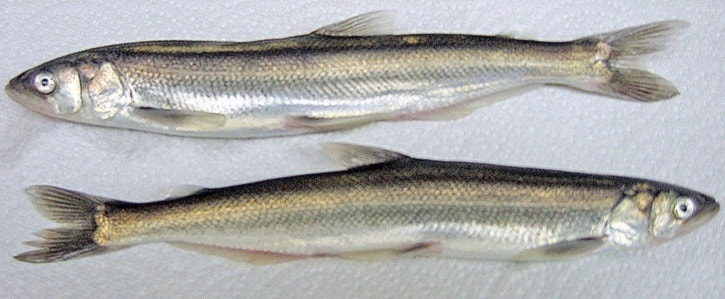Eulachon are starting to enter the Fraser River now, returning to natal streams from the ocean to spawn.
It's a tiny fish, a type of smelt known at one time for swimming up the river in a huge, shimmering biomass each spring.
The eulachon have always been special to the Sto:lo, said Ken Malloway, chair of the Lower Fraser Fisheries Alliance, and a Sto:lo fisherman.
Sometimes spelled oolichan, or ooligan, they are also known as candlefish on the Pacific Coast, due to the high oil content of the fish. In some parts of the province eulachon were rendered into grease and traded along the Grease Trail.
Decades ago, a Sto:lo man used to live atop Chilliwack mountain whose function it was to alert everyone when the tiny fish would enter the river system, said Malloway. The eulachon often showed up just as winter food stores ran out and runners would bring the message to various Sto:lo villages.
"Everyone would go fishing for eulachons," Malloway said. "They'd fill their canoes in just an hour and then they would smoke them, and also have a feast of fresh ones."
It used to be such a large biomass, that it would be followed closely up the river by seals and sea lions, and then killer whales would also head up the Fraser after the seals.
The Sto:lo call the fish, sweswa, which literally means bands of silver, Malloway said. That's what the fish looked like in the water when they hit the Chilliwack part of the river system — two bands of silver.
But not anymore, as numbers have dropped off dramatically.
"We haven't seen that for 30 or 40 years," said Malloway, adding that he hasn't fished for eulachon for years since they started to die off.
Sto:lo Tribal Council president Clarence Pennier said they are asking that DFO rethink the eulachon plan for 2013.
DFO limited 30 First Nations on the Lower Fraser River, with a combined population of 10,000 people, to a catch of only 400 pounds of eulachon last year, he said.
"We didn’t fail to notice that DFO allowed the commercial shrimp trawl fleet to take up to eight tonnes of eulachon as by-catch."
The problem is that the trawl fleet has no market for eulachon. Eulachon taken as by-catch are simply chucked overboard, and only part of the catch is monitored.
"This is a highly wasteful and morally repugnant practice and it must be stopped immediately," Pennier wrote to DFO.
The Fraser River eulachon was designated as threatened by COSEWIC but has not been listed as endangered under the Species At Risk Act.
Historically the bulk of the eulachon interception in the shrimp trawl fishery occurred in waters off the west coast of Vancouver Island and in Queen Charlotte Sound, according to DFO media spokesperson Leri Davies.
"Management measures have been implemented to reduce the eulachon by-catch over the past decade," she wrote in a emailed response.
"These measures include closures of areas of concern, for example, Queen Charlotte Strait has been closed to shrimp trawl fishing since 1999 because of concerns over eulachon by-catch. Other actions in the shrimp fishery include the introduction of By-catch Reduction Devices.With the implementation of the grids and the reduction in boats participating the impact on eulachon has decreased dramatically."
Estimates of eulachon by-catch in shrimp trawl fisheries off Vancouver Island has dropped significantly from an estimated 65 tonnes in 2000, to less than half a tonne since 2006.
"The Government of Canada is considering listing two populations of eulachon under the Species at Risk Act: the Central Pacific Coast eulachon population as Endangered; and the Fraser River eulachon population as Endangered," said Davies.
DFO officials have told Sto:lo officials their fishery for eulachon will be limited 800 pounds this year.
"This is unacceptable constraint on our fishermen in light of the on-going trashing of this species by the shrimp trawl fleet and the fact that more than 120 tonnes of eulachon is expected this season," wrote Pennier in the letter dated April 4.
Malloway called it "a slap in the face," and said he doesn't see why First Nations couldn't be given the eulachon by-catch.
The tribal council is asking DFO to "sharply curtail" the impacts of the shrimp trawl fishery and clamp down on the sport fishery take of eulachon as bait for the Sturgeon sport fishery.
"We insist that our rights to a fishery for eulachon be respected and that DFO work with our communities to come up with a more acceptable fishing plan for eulachon in 2013," concluded Pennier.
jfeinberg@theprogress.com
Twitter.com/chwkjourno
